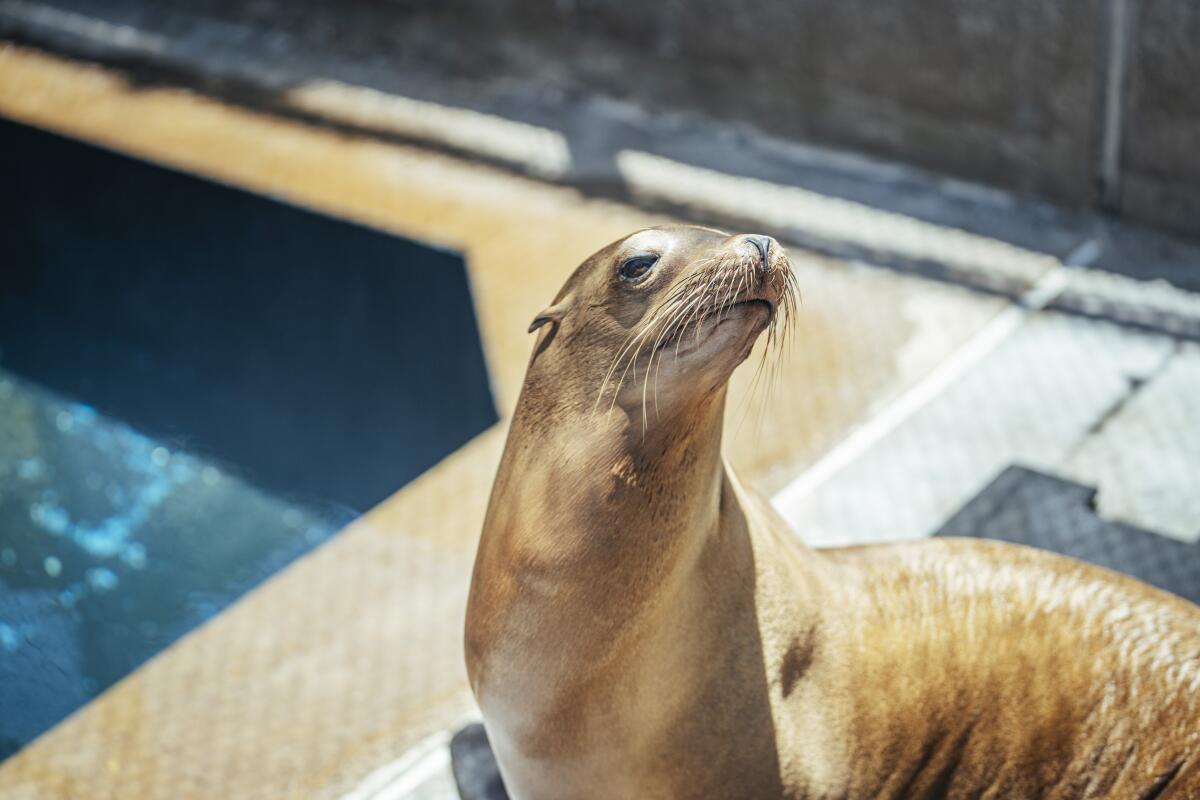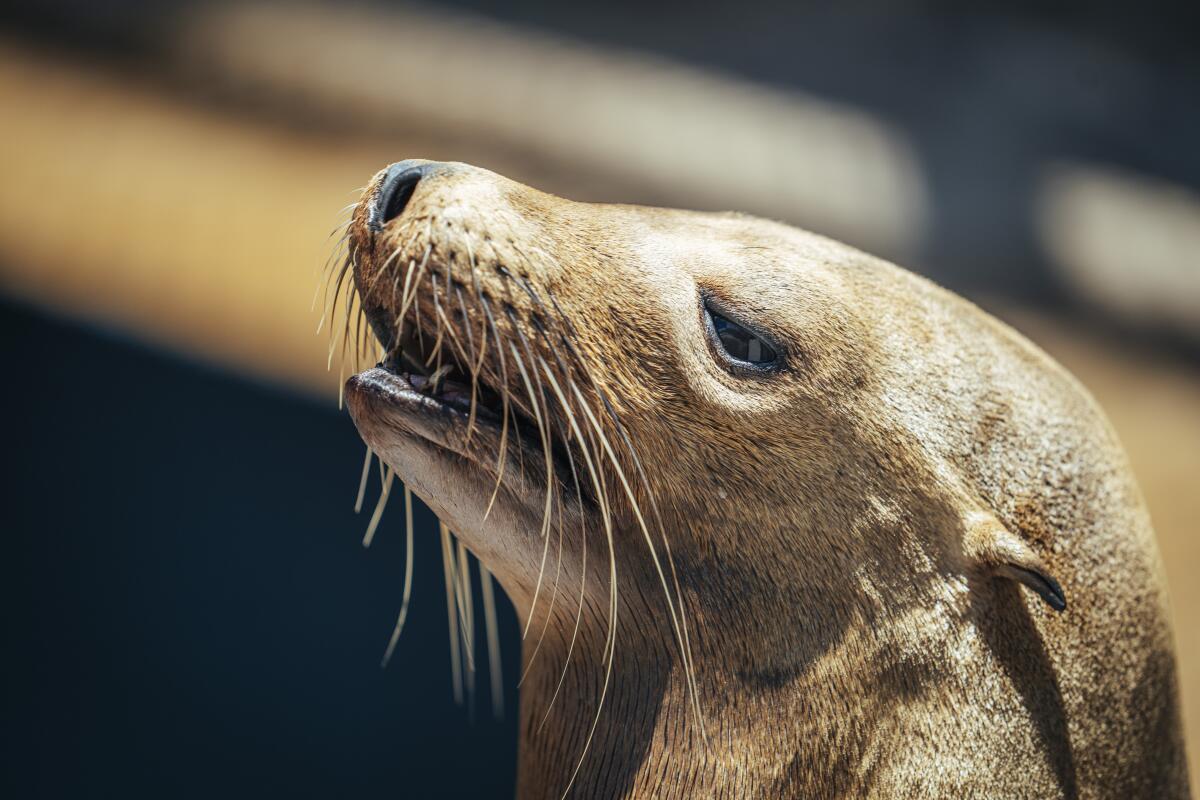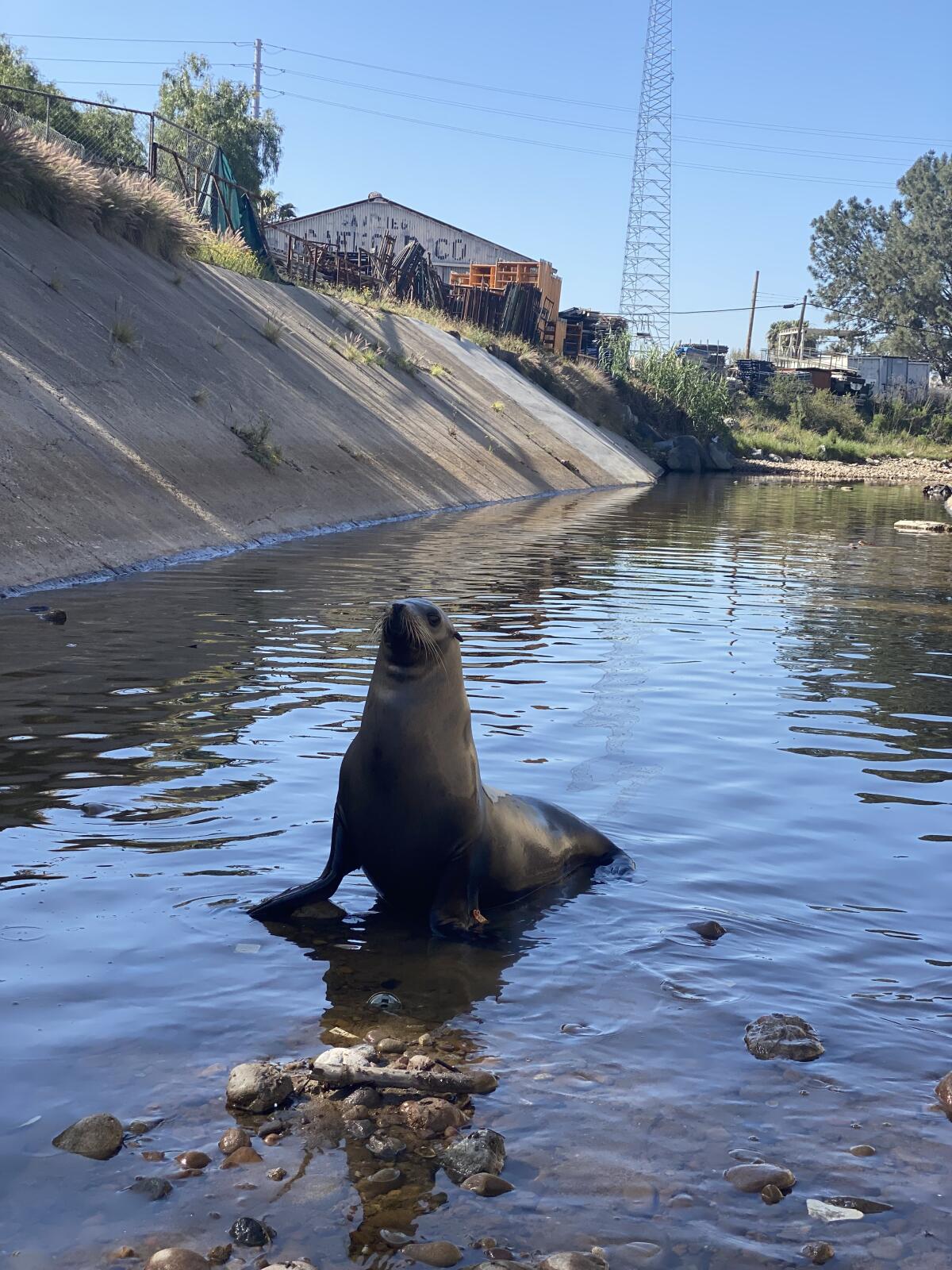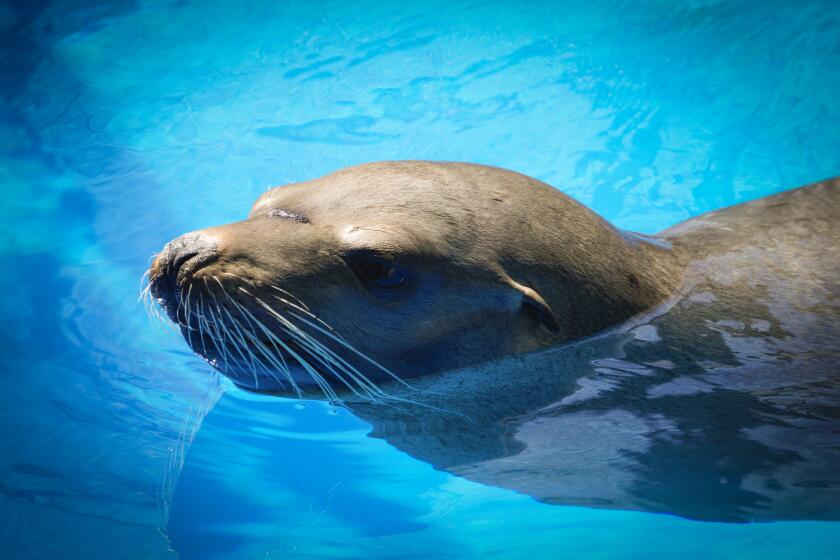San Diego now seeing an uptick in sick, disoriented and potentially aggressive sea lions washing ashore

Local experts are asking beachgoers to keep a safe distance and report strandings, amid a bloom of toxic algae that produces a neurotoxin that damages some marine mammals’ brains.
- Share via
San Diego — Algae blooming along the California coast — so toxic that it’s causing fatal brain damage in sea lions and dolphins — has reached San Diego, resulting in a recent surge of sick and potentially aggressive animals washing ashore.
And as San Diegans prepare to flood local beaches ahead of the Fourth of July holiday and oncoming heat wave, local veterinarians are advising beachgoers to keep a safe distance from any marine mammal in distress.
This story is for subscribers
We offer subscribers exclusive access to our best journalism.
Thank you for your support.
“Give them as much space as possible, because with this neurotoxin, they’re not acting normally,” Justin Viezbicke, stranding coordinator for NOAA Fisheries, said during a press briefing Friday.
The rapid growth of the marine algae Pseudo-nitzschia produces a neurotoxin called domoic acid, which damages the brain and heart of infected marine mammals and can cause them to behave unusually aggressively toward humans.
Although algae blooms are a natural phenomenon and seasonal outbreaks of domoic acid poisoning are common along the coast, experts say the scope of this year’s animal poisonings is worse than usual.
“For about the last month, southern California has experienced a harmful algal bloom on a scale we have not seen before,” said NOAA Fisheries spokesperson Michael Milstein.
High concentrations of domoic acid were first found in waters near Santa Barbara and Ventura counties in early June.
Over the last month, sea lions and dolphins were reported to be dying off by the hundreds, with the Channel Islands Marine & Wildlife Institute in Santa Barbara fielding over 1,000 reports of sick and dead animals in just one week, according to a NOAA Fisheries report.
SeaWorld San Diego is part of the West Coast Stranding Network and has sent rescue team members to support other facilities in rescuing animals in areas hit hardest.
But as the toxin has trickled down the coast, SeaWorld’s rescue team has begun seeing an uptick of rescue calls of its own here in San Diego.
“We see these animals coming in every year, but this is just a big bloom,” said SeaWorld San Diego veterinarian Dr. Kelsey Herrick. “This is the biggest one I’ve seen in my career.”

In the last few weeks, SeaWorld has responded to more than a dozen poisoned animals — mostly sea lions, along with one dolphin. Ten had been taken back to the center for evaluation and rehabilitation as of Thursday.
“We’re getting calls daily about some of the abnormal behaviors of sea lions and dolphins,” said SeaWorld San Diego spokesperson Tracy Spahr.
Even with the uptick, the rescue team is gearing up and preparing for the worst, Herrick said.
SeaWorld staff veterinarian Dr. Jenn Russell explained that the domoic acid travels up the food chain — from the plankton that eat the algae to squid and shellfish to the larger marine mammals that then eat them.
Top predators ingest the most toxins and get the sickest, resulting in neurological symptoms that can range from abnormal behavior and disorientation to seizures and even death, added Herrick.
The acid destroys the brain until the animals no longer know basic survival functions, such as how to evade predators and find food.
Rescue centers try to flush the toxins out of an animal’s system, but some animals suffer irreversible brain damage.
Only about half of the animals SeaWorld has rescued thus far have survived.
Monitoring the toxins
Harmful algae blooms are typically a result of upwelling, a process that brings cold, nutrient-rich water from the deep ocean to the warm surface and stimulates algae growth, explained Clarissa Anderson, a biological oceanographer and harmful algae bloom expert at the Scripps Institution of Oceanography at UC San Diego.
This often produces what is known as a “red tide” when it happens close to shore — but it sometimes happens in deeper, offshore waters, as with the current bloom.
What makes this event so unusual, Anderson said, is the number of dolphins being affected due to the algae blooming off-shore, as the toxins are usually seen primarily in sea lions and birds that live closer to shore.
Anderson is executive director of the Southern California Coastal Ocean Observing System, which is responsible for monitoring harmful algae. It uses data from samples collected weekly at nine university-run or municipal pier stations from San Diego to Humboldt counties to help predict when and where toxic blooms occur.
In this instance, because that data is collected near the shore, Anderson says the toxins are only now starting to appear on the system’s radar and have been steadily increasing.
“Right now, those maps are showing high domoic acid risk for almost the entire state,” she said.
Even so, Anderson believes the bloom won’t last much longer, as oceanographic conditions change and there are fewer upwellings to stimulate blooms.
Although Anderson says this recent bloom was likely caused by natural ocean processes, oceanographers are studying other environmental factors — such as climate change, greenhouse gas emissions and urban runoff — that might be causing algae blooms to occur more frequently.
“We’re still trying to understand why we seem to see so much more toxicity … than we think we used to,” she added.
Steer clear of distressed animals
Aggression toward humans is not typical for sea lions, but sick animals are more vulnerable and prone to attacking anyone who gets too close.
Sea lions have reportedly attacked nearly two dozen people in recent weeks, mostly in shallow waters, though a handful have been on the beach, according to Viezbicke, the NOAA Fisheries coordinator.
“Sometimes when they’re just lying still on the beach, it’s not apparent that they’re having brain seizures, but they can be really erratic,” Anderson said.
The toxin does not affect humans unless they consume it in contaminated food — but sea lions suffering seizures are often completely unaware of their surroundings and can swim into surfers or bite people on the beach as a result.
These confused animals also often wander out of the water and onto nearby roads and private property, local veterinarians said.

One such animal was Freeway, a land-loving sea lion that gained notoriety last year when he wandered inland, traveling through storm drains and even attempting to scoot across state Route 94. His recent death can now be attributed to the toxin, after a postmortem exam showed the lesions in his brain were consistent with domoic acid intoxication, SeaWorld confirmed.
The pinniped known as Freeway had contracted a progressive disease before being rescued last year, SeaWorld said on Facebook; ‘Despite extensive treatment, the disease caused his health to deteriorate over time.’
Beachgoers are advised not to approach marine mammals and stay at least 100 yards away. They are also encouraged to alert lifeguards or rescue centers if they spot an animal that’s aggressive or in distress.
Callers will be asked to provide specific information about the animal, such as when it was last seen, as well as its location, size and condition.
Those who see an animal in need of help can contact SeaWorld’s rescue team at 1-800-541-SEAL (7325) or [email protected].
More to Read
Sign up for Essential California
The most important California stories and recommendations in your inbox every morning.
You may occasionally receive promotional content from the Los Angeles Times.












